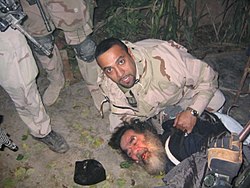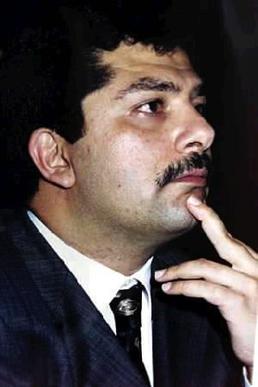
Qusay Saddam Hussein al-Nasiri al-Tikriti was an Iraqi politician, military leader, and the second son of Saddam Hussein. He was appointed as his father's heir apparent in 2000. He was also in charge of the Republican Guard. Qusay and his brother Uday were killed in a U.S. raid in Mosul.
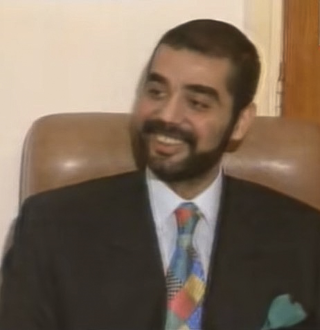
Uday Saddam Hussein was an Iraqi politician and the elder son of Saddam Hussein. He held numerous positions as a sports chairman, military officer and businessman, and was the head of the Iraqi Olympic Committee and Iraq Football Association, and head of the Fedayeen Saddam.

The United States-led invasion of the Republic of Iraq was the first stage of the Iraq War. The invasion phase began on 19 March 2003 (air) and 20 March 2003 (ground) and lasted just over one month, including 26 days of major combat operations, in which a combined force of troops from the United States, the United Kingdom, Australia and Poland invaded Iraq. Twenty-two days after the first day of the invasion, the capital city of Baghdad was captured by coalition forces on 9 April 2003 after the six-day-long Battle of Baghdad. This early stage of the war formally ended on 1 May 2003 when U.S. President George W. Bush declared the "end of major combat operations" in his Mission Accomplished speech, after which the Coalition Provisional Authority (CPA) was established as the first of several successive transitional governments leading up to the first Iraqi parliamentary election in January 2005. U.S. military forces later remained in Iraq until the withdrawal in 2011.
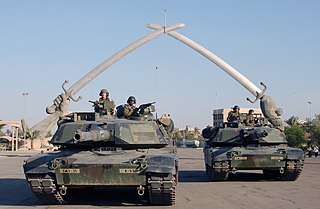
The following is a timeline of major events during the Iraq War, following the 2003 invasion of Iraq.
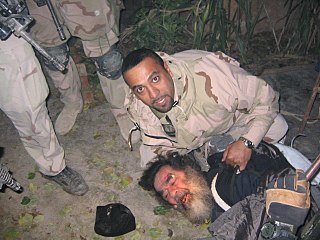
Saddam Hussein, the deposed president of Iraq, was captured by the United States military in the town of Ad-Dawr, Iraq on 13 December 2003. Codenamed Operation Red Dawn, this military operation was named after the 1984 American film Red Dawn.

Lieutenant General Abid Al-Hamid Mahmud al-Tikriti was an Iraqi military officer and Saddam Hussein's personal secretary.
The following lists events in the year 2003 in Iraq.

Task Force 20 is a temporary combat force designation that has been used several times and may still be used by separate parts of the United States armed forces. The longer-established iteration was a part of the United States Second Fleet in the Atlantic from after the Second World War. This was part of the formal United States Military Communications-Electronic Board system.
Task Force 6–26 is a United States Joint military/Government Agency, originally set-up to find "High-Value Targets" (HVT's) in Iraq in the aftermath of Operation Iraqi Freedom. This Special Operations unit is very similar to JSOC Task Force 121 which was created to capture Saddam Hussein and high-ranking Al-Qaeda members. The various name changes seen by the group are to ensure Operational Security, although their makeup and goals largely remain the same. The main objective of Task Force 6–26 was the capture or liquidation of terror leader Abu Musab al-Zarqawi, who led Al-Qaeda in Iraq. The unit is made up of U.S. Special Operations Forces members including Delta Force, DEVGRU, 24th Special Tactics Squadron and the 75th Ranger Regiment along with the CIA's Special Activities Center. Other military and DIA personnel are believed to have been involved as 'limited' members of the unit, along with FBI agents.
In United States military terminology, high-value target (HVT) is the term used to describe a person or resource which an enemy commander can least afford to lose. The term has been widely used in the news media for Osama bin Laden and high-ranking officers of al-Qaeda and other terrorist organizations. Former Iraqi President Saddam Hussein was known as High-Value Target Number One by the United States military before his capture.
The terms Tier One Special Mission Unit and Special Missions Unit (SMU) are used, particularly in the United States, to describe some highly secretive and elite military special operations forces. Special mission units have been involved in high-profile military operations, such as the killing of Osama bin Laden.

Dora is a neighborhood in Al Rashid administrative district, southern Baghdad, Iraq. Before the 2003 U.S. invasion of Iraq, it was home to the city's largest concentration of Christian Assyrians, as well as Mandaeans and Muslim families.
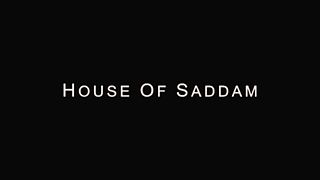
House of Saddam is a 2008 British docudrama television miniseries that charted the rise and fall of Saddam Hussein. A co-production between BBC Television and HBO Films, the series was first broadcast on BBC Two in four parts between 30 July and 20 August 2008.

Joint Special Operations Command Task Force in the Iraq War was a joint American and British special operations unit, of which little is publicly known. It is described as a "hunter-killer team" with its core made up of the United States Army's 1st Special Forces Operational Detachment-Delta and the 75th Ranger Regiment, as well as the United States Naval Special Warfare Development Group and members of the United States Air Force's 24th Special Tactics Squadron, all under Joint Special Operations Command (JSOC) and elements from the United Kingdom Special Forces, including the Special Air Service, Special Boat Service (SBS), Special Reconnaissance Regiment (SRR), 18 (UKSF) Signal Regiment and the Special Forces Support Group (SFSG). The unit was reported to be responsible for the cross border raid into Syria from Iraq in October 2008 that resulted in eight deaths including Abu Ghadiya, along with several US operations in the Horn of Africa targeting al-Qaeda.

This is the order of battle for the invasion of Iraq during the Iraq War between coalition forces and the Iraqi Armed Forces; Fedayeen Saddam irregulars; and others between March 19 and May 1, 2003.

Uday and Qusay Hussein, sons of deposed Iraqi President Saddam Hussein, were killed during an American military operation conducted on July 22, 2003, in the city of Mosul, Iraq. The operation originally intended to apprehend them, but turned into a four-hour gun battle outside a fortified safehouse which ended with the death of the brothers, Qusay's son Mustafa, and a bodyguard, Abdul Samad al-Hadushi.
